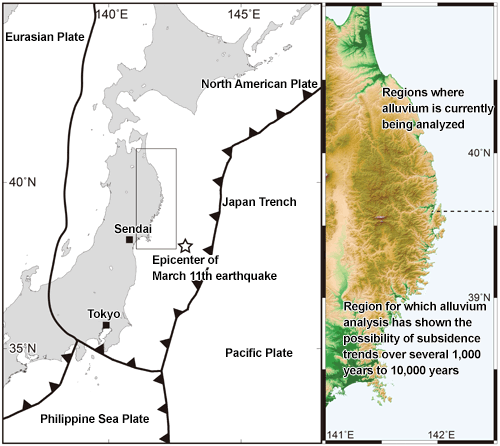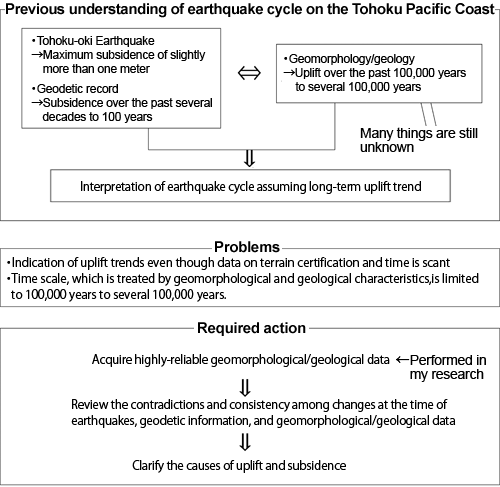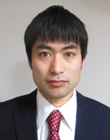Top>Research>Research on Alluvium/Crustal Movement on the Sanriku Coast—Working to Clarify the Cycle of Megathrust Earthquakes
Research on Alluvium/Crustal Movement on the Sanriku Coast—Working to Clarify the Cycle of Megathrust Earthquakes
Yuichi Niwa
Research Associate, Faculty of Science and Engineering, Chuo University
Areas of Specialization: Earth Science, Geomorphology, Quaternary Research
Earthquake cycle in the Tohoku Pacific Coast
At the time of the Tohoku-oki Earthquake of 2011, a maximum subsidence of slightly more than one meter occurred on the Sanriku Coast, an area along the Pacific Coast of the Tohoku region[1]. Geodetic records show that this area had trends of subsidence for several decades to 100 years prior to 2011[2]. It was also previously pointed out that the Sanriku Coast is spotted with marine terraces which were formed by the uplift of shallow marine areas. It has been said that uplift trends existed for the past 100,000 to several 100,000 years[3]. Subsidence takes place over the short term, while uplift occurs over the long term. Based on the direction of these crustal movement phenomena with different applicable periods, scientists have proposed models for earthquake cycles which ultimately arrive at uplift trends along the Sanriku Coast[4].
Problems in geomorphological and geological research aimed at clarifying earthquake cycles
The existence of marine terraces is said to be evidence for long-term uplift trends on the Sanriku Coast. However, in actuality, there is scant information on terrain certification and formation age. For example, in the southern half of the Sanriku Coast, the distribution of flat surfaces which have been assumed to be marine terraces is fragmented[3], so they cannot be strictly referred to as marine terraces. At the current point in time, the distribution characteristics of marine terraces cannot be used as the sole basis for inferring a crustal movement trend on the Sanriku Coast over 100,000 years to several 100,000 years. Therefore, it is necessary to use other geomorphological and geological characteristics to estimate crustal movement on a longer time scale than geodetic survey.


Figure 1: Location of the Sanriku Coast; research background, problems, and issues requiring resolution
Alluvium as a record of crustal movement
In order to estimate crustal movement on a longer time scale than geodetic observation, I am conducting research which focuses on the alluvial plains that are scattered on the Sanriku Coast. Alluvium has been formed in an environment close to the land-sea border during about the last 10,000 years. If it were possible to use collected alluvium samples to identify sediment that was deposited around the sea-level, it might be possible to estimate crustal movement from the characteristics of sediment stacking pattern and from the distribution elevation/age of that sediment. I am currently conducting this research on multiple alluvial plains that are distributed along the Sanriku Coast[5].

Figure 2: Example of alluvium samples—Estimating the sedimentary environment from the sediment diameter, sedimentary structure, and characteristics of the contained fossils
Crustal movement estimated on the Sanriku Coast
On the south of Miyako on the Sanriku Coast, we have observed aggradation of delta sediment. This indicates that subsidence has caused a relative sea-level rise. We also observed paleo sea-level lower than the sea level assumed to have existed when there were no uplift or subsidence. These observations showed the possibility of a subsidence trend during the past several 1,000 years to 10,000 years on the southern half of the Sanriku Coast[5]. In other words, for at least the southern half of the Sanriku Coast, it is necessary to reflect the subsidence trends of the past several 1,000 years to 10,000 years when interpreting the earthquake cycle. Moving forward, I plan to analyze alluvium in the northern half of the Sanriku Coast, to review whether or not crustal movement is similar in all areas of the coast, and to collect fundamental knowledge for clarification of the earthquake cycle model.
- Yuichi Niwa
Research Associate, Faculty of Science and Engineering, Chuo University
Areas of Specialization: Earth Science, Geomorphology, Quaternary Research -
Yuichi Niwa was born in Aichi Prefecture in 1983. In 2007, he graduated from the Department of Earth Science in the School of Science, the University of Tokyo. In 2012, he completed the Doctoral Program in the Department of Natural Environmental Studies of the Graduate School of Frontier Sciences, the University of Tokyo. He holds a PhD in environmental science.
Niwa worked as Assistant Professor at the International Research Institute of Disaster Science at Tohoku University before assuming his current position in 2017.
He specializes in geomorphology and Quaternary research. After the 2011 Tohoku-oki Earthquake, he has actively researched the geomorphological and geological features of the Sanriku Coast, working to decipher crustal movement with the aim of clarifying the cycle of megathrust earthquakes.
In particular, his main research focuses on reconstructing the development process of the alluvial plain and estimating crustal movement based on the process.
- Research Activities as a Member of Research Fellowship for Young Scientists (DC1), Japan Society for the Promotion of Science (JSPS) Shuma Tsurumi
- Important Factors for Innovation in Payment Services Nobuhiko Sugiura
- Beyond the Concepts of Fellow Citizens and Foreigners— To Achieve SDGs Goal 10 “Reduce Inequality Within and Among Countries” Rika Lee
- Diary of Struggles in Cambodia Fumie Fukuoka
- How Can We Measure Learning Ability?
—Analysis of a Competency Self-Assessment Questionnaire— Yu Saito / Yoko Neha - The Making of the Movie Kirakira Megane

-
Newest Edition 2019 Autumn Issue
Student journalists report on the students’ take of Chuo University

-
Chuo-DNA
The school's history and motto have been passed on to graduates and students alike. Here is a visualization of Chuo University in the future.Core Energy
Launching Chuo University's Knowledge into Action to the rest of the world, like an infinity of sparkling stars scattered throughout space.
Planned by The Yomiuri Shimbun Business Bureau [PR]















